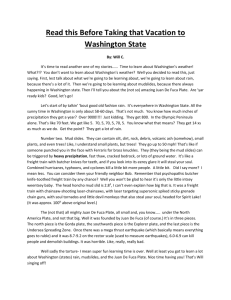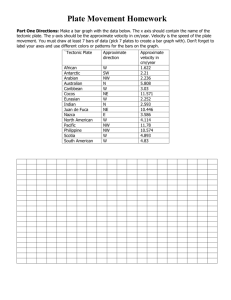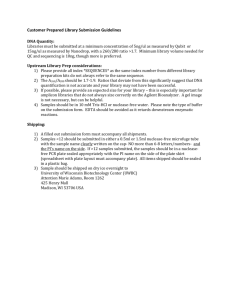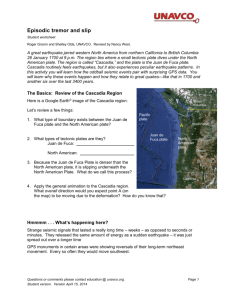Plate Motion Problem Set
advertisement
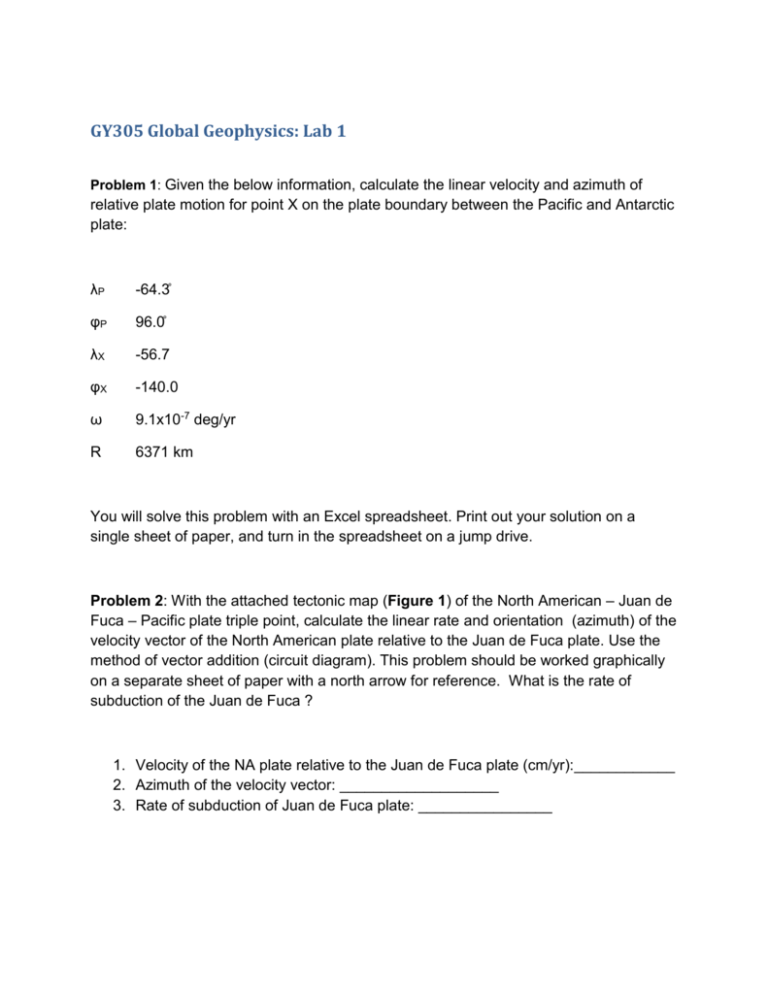
GY305 Global Geophysics: Lab 1 Problem 1: Given the below information, calculate the linear velocity and azimuth of relative plate motion for point X on the plate boundary between the Pacific and Antarctic plate: λP -64.3̊ φP 96.0̊ λX -56.7 φX -140.0 ω 9.1x10-7 deg/yr R 6371 km You will solve this problem with an Excel spreadsheet. Print out your solution on a single sheet of paper, and turn in the spreadsheet on a jump drive. Problem 2: With the attached tectonic map (Figure 1) of the North American – Juan de Fuca – Pacific plate triple point, calculate the linear rate and orientation (azimuth) of the velocity vector of the North American plate relative to the Juan de Fuca plate. Use the method of vector addition (circuit diagram). This problem should be worked graphically on a separate sheet of paper with a north arrow for reference. What is the rate of subduction of the Juan de Fuca ? 1. Velocity of the NA plate relative to the Juan de Fuca plate (cm/yr):____________ 2. Azimuth of the velocity vector: ___________________ 3. Rate of subduction of Juan de Fuca plate: ________________ Figure 1: Tectonic map of the Pacific - North Am. - Juan De Fuca triple point. Problem 3: Using the Figure 2 map in your text, measure the latitude and longitude values of at least six equally spaced points located on the UDINTSEV fracture zone associated with the east Pacific Rise. Plot these points on a stereographic projection as a series of points. Convert these points to directional angle values, and best-fit a small circle geometry through the points. The apical axis point of the fit will be the pole of rotation between the Antarctic and Pacific plates. Convert the apical point back to geographic coordinates. Turn in the following materials for this problem: 1. Table of measured geographic coordinates of the fracture zone. 2. Manual plot of geographic coordinates on a stereographic projection (right side = 0̊ longitude) 3. Hard copy of best-fit small circle (use NETPROG program). 4. List both possibilities of the geographic coordinates of the pole of rotation between the two plates. Figure 2: Map of East Pacific Rise transforms. Problem 4: Given the latitude-longitude coordinates of the 4 corners of a hypothetical tectonic plate, and the lat-long coordinates of the pole of rotation, use an equal-angle stereographic projection to rotate and plot the new plate corner coordinates after 70 degrees of counter-clockwise rotation (viewed down-plunge) about the pole of rotation: Corner 1 Latitude Longitude 40N 49W Corner 2 40N 30W Corner 3 10N 50W Corner 4 10N 20W Pole 40N 154E Draw straight lines connecting the original corner points as the starting position of the plate, and do the same for the rotated corners to show the new position. On the stereonet make sure that you include tic marks for the cardinal directions, label north with an “N”, and make a “+” mark at the center of the stereonet. Make the stereonet radius 3.5 inches.
